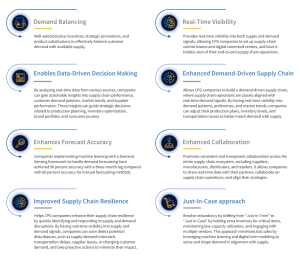Leveraging Supply and Demand Sensing to Optimize the CPG Supply Chain
The consumer-goods industry has been warding off an array of “Black Swan” events and challenges, such as shifts in consumer expectations and purchasing habits, high inflation and low GDP growth in some large economies, and a global pandemic that created seismic upheaval. The consumer-packaged goods (CPG) industry is highly competitive, with supply-chain complexities, market dynamics, and varying consumer demands.
Upstream Supply Challenges
- New research says companies can now expect significant disruptions like pandemics, lasting at least a month every 3.7 years
- Sourcing threats due to the pandemic, weather disruptions to, labor shortages, inflation, war, and political unrest
- The lack of visibility of supplier risks raises the question if we can leverage Friendshoring or Nearshoring to create secure supply networks
- Port congestion, strikes, and transportation challenges like the Suez Canal blockage
- Fluctuations in freight tariff and supplier production capacity due to supply-demand mismatch
Downstream Demand Challenges
- Volatile demand patterns due to inflation pressures. An increase in inflation drives consumers to opt for lower-priced options or private labels over their trustworthy brands.
- High vulnerability to both shrinking margins and shifting consumer demand spikes.
- Frequent promotions and markdowns due to miscalculated and high inventory stocks.
- With shifting variables, consumer goods companies are under immense pressure to secure their products in retailers’ assortments and meet demand cost-effectively.
- Lack of demand forecasting accuracy due to increased omni-sale-channels and hyper-personalization to consumers.
- Lack of detailed insights into supply, inventories, production, and demand leads to overproduction, spoilage, shortages, and missed opportunities.
Supply and Demand Sensing
Supply and Demand Sensing, powered by advanced analytics and real-time data, is emerging as a game-changer in the CPG supply chain—enabling companies to achieve greater agility and resilience. To be successful in this challenging and VUCA (Volatility, Uncertainty, Complexity, Ambiguity) environment, Consumer Goods companies must be able to rely on the collaborative framework of “Supply & Demand Sensing.”
“Supply Sensing” focuses on collating real-time data related to the movement of goods and materials across the upstream supply chain from various internal and external sources. In contrast, “Demand Sensing” focuses on capturing real-time data related to customer demand patterns, preferences, fulfillment and distribution, and market trends.
While Demand Sensing in the supply chain has numerous benefits, there can be challenges while implementing it in the CPG supply chain. To address these challenges, CPG companies can follow these best practices.
“Supply Sensing” – Best Practices
More than implementing demand forecasting, improvements are required; the supply side of the value chain must become more agile. Supply Sensing understands consumer or customer demand and applies the sensing framework to predict supply disruptions. Companies can better forecast when supply disruptions may happen and take action sooner to limit this risk by knowing the variables that contribute to supply volatility or disruptions. These could fundamentally alter how availability is guaranteed and unexpected price shocks are avoided.
The supply Sensing framework adopts the following practices for a responsive and resilient supply chain:
- Implement “supplier operational health tracking” and use the insights to make informed decisions on safety stock targets.
- Secure additional capacity by increasing the share of contract manufacturing capacity and expanding their base.
- Increase flexibility on the supply side by expediting the approval process for onboarding contract manufacturers and critical raw material providers.
- Drill down supplier inventory levels for critical ingredients and implement real-time visibility. For example, some food and beverage companies are developing alternative recipes should key components become unavailable.
- Shift procurement infrastructure from “category experts” to procurement “athletes” and assign the best minds to work on problem areas.
“Demand Sensing” – Best Practices
Demand Sensing helps you bridge the gap between planning and execution. It can include additional data signals in the weekly forecast and disaggregates the weekly forecast to days by recognizing the patterns in your daily demand.
The Demand Sensing framework adopts the following practices for a responsive and resilient supply chain:
- Tightens the planning cycle from monthly to weekly intervals and involves leadership for faster decision-making on product allocation and substitutions.
- Proactive customer management: Provides additional transparency, proactively balancing the bullwhip effect of surging consumer demand with enhanced point-of-sale visibility.
- Optimize SKU portfolio complexity: Ensure supply chain priorities are aligned with commercial concerns. Leaders have beaten the market by making bold portfolio decisions, such as reducing SKU complexity by 80 to 90 percent.
Key Benefits of Supply and Demand Sensing in the CPG Supply Chain

The Path Forward
“People don’t want to buy a quarter-inch drill. They want a quarter-inch hole.”
-Theodore Levitt, Professor, Harvard Business School
“Consumers do not want a two-day lead time; they want a present for their child’s birthday – Available to fulfill the promise and help in gift wrapping.” The future supply chain of consumer-goods industry is consumer enabled and expected to drive commercial innovation capabilities to fuel competitive advantage and support revenue like:
- Supply chain capabilities “as-a-service” to other organizations.
- Differentiated supply chain service across the customer journey.
- Create a cost-to-serve model.
The “Supply and Demand Sensing” framework is fulfilling the gaps and getting inculcated across CPG supply chains which contribute to success across CPG majors like Coca-Cola and P&G beating the revenue estimates; “Loreal” ensuring high “Case Fill Rate” to its customer like “Amazon”; “Unilever” retaining its flagship brand “Lifebuoy” as world’s No.1-selling germ-protection soap, despite demand spikes and “Kellogg’s” transforming Supply Chains into Revenue center.
Undoubtedly, the “Supply and Demand Sensing” framework is the need of the hour to revolutionize and transform the CPG Supply chain in a consumer-based digital era. By leveraging supply and demand sensing in the supply chain, organizations can achieve optimized inventory levels and reduced stockouts, leading to greater profitability, operational efficiency, and customer satisfaction.
Latest Blogs
A closer look at Kimi K2 Thinking, an open agentic model that pushes autonomy, security, and…
We live in an era where data drives every strategic shift, fuels every decision, and informs…
The Evolution of Third-Party Risk: When Trust Meets Technology Not long ago, third-party risk…
Today, media and entertainment are changing quickly. The combination of artificial intelligence,…




